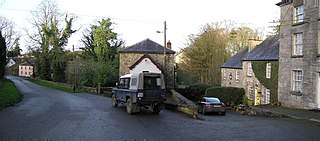See:
See:
Tara may refer to:

A listed building, or listed structure, is one that has been placed on one of the four statutory lists maintained by Historic England in England, Historic Environment Scotland in Scotland, Cadw in Wales, and the Northern Ireland Environment Agency in Northern Ireland.
The vast majority of placenamesin Ireland are anglicisations of Irish language names; that is, adaptations of the Irish names to English phonology and spelling. However, some names come directly from the English language, and a handful come from Old Norse and Scots. The study of placenames in Ireland unveils features of the country's history and geography and the development of the Irish language. The name of Ireland itself comes from the Irish name Éire, added to the Germanic word land. In mythology, Éire was an Irish goddess of the land and of sovereignty.
In England and Wales, Northern Ireland, and the Republic of Ireland, an urban district was a type of local government district that covered an urbanised area. Urban districts had an elected urban district council (UDC), which shared local government responsibilities with a county council.

Ramelton, also Rathmelton, is a town in County Donegal, Ireland. As of 2016, its population was 1,266.
Creagh is an Irish surname derived from the Gaelic Craobhach, meaning "branch". The Creagh family was first found in County Clare, where they held a family seat from ancient times. It is also the name of several locations throughout the island of Ireland, for example:
Ballymartin is one of several places on the island of Ireland.

Cullaville or Culloville (from Irish: Baile Mhic Cullach, meaning 'MacCullach's townland' or McCulloch's ville or town is a small village and townland near Crossmaglen in County Armagh, Northern Ireland. It is the southernmost settlement in the county and one of the southernmost in Northern Ireland, straddling the Irish border. In the 2001 Census it had a population of 400 people. The village is on a busy crossroads on the main Dundalk to Castleblaney road ; three of the roads lead across the border and the fourth leads to Crossmaglen.
Aghadrumsee is a small village in south-eastern County Fermanagh, Northern Ireland.

Rathmullan is a small seaside village on the Fanad Peninsula in County Donegal, Ireland. It is situated on the western shore of Lough Swilly, 11 km (7 miles) north-east of Ramelton and 12 km (7.5 miles) east of Milford. Rathmullan serves as an important historical village as it was the scene of the Flight of the Earls in 1607, a major turning point in Irish history.

Malin is a village in County Donegal, Ireland, situated 6 km (4 mi) north of Carndonagh. A further 13 km (8 mi) north further is Malin Head, the most northerly point of the island of Ireland . Malin won the Irish Tidy Towns Competition in 1970 and 1991. It was a planned settlement plotted around a triangular green.

Ireland has an extensive network of public roads which connect all parts of the country with each other. Roads in Ireland are currently classified as motorways, National Primary routes, National secondary routes, Regional roads and Local roads. The introduction of this classification system began in 1977.

Glaslough is a village and townland in the north of County Monaghan, Ireland, on the R185 regional road 3 km (2 mi) south of the border with Northern Ireland and 10 km (6 mi) northeast of Monaghan town. Glaslough won the Irish Tidy Towns Competition in 1978 and again in 2019.
Tully may refer to:

Ardnacrusha is a village in County Clare, Munster, Ireland, located on the northern bank of the River Shannon. By road, it is 6.6 kilometres (4.1 mi) north of Limerick. The name derives from the phrase Ard na Croise meaning "the height of the cross", due to a large cross marker placed there in 1111 to mark the boundary of the Diocese of Limerick.